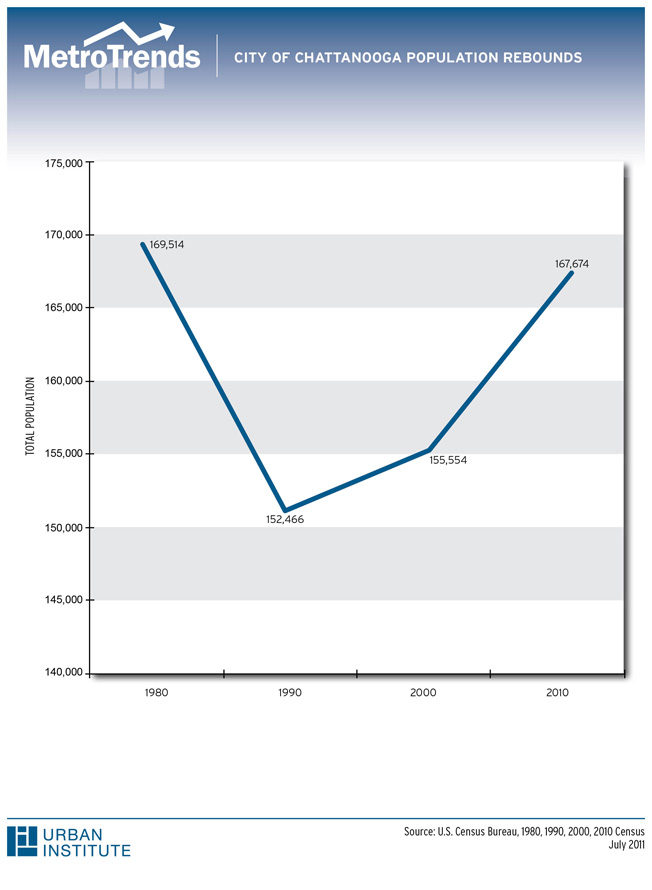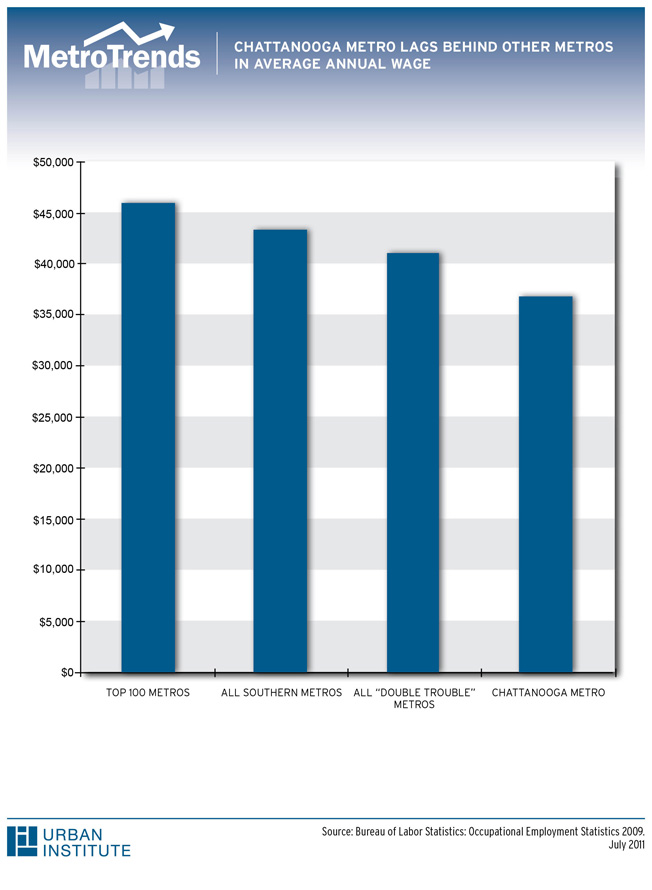
|
|
Metropolitan Spotlights Our metropolitan spotlights focus on selected metros, showing how they're faring relative to others in their region and nationally. Bounding Back: The Chattanooga StoryThe Chattanooga metropolitan region lies in the Tennessee River Valley, a region well-known for its scenic beauty. The area is a nexus of interstates and rail lines, and the river has long been a transportation corridor. The core of the region is Hamilton County and the City of Chattanooga, the 4th largest city in Tennessee. The Dynamo of Dixie, as this city is sometimes called, has a comeback story that illustrates what city leaders and stakeholders can do when they are committed to revitalization. Chattanooga has long had a history of manufacturing. Smokestack waste earned Chattanooga the moniker of "the dirtiest city in America" in 1969. As manufacturing jobs declined in the 1970s and 1980s, so did the population of the city. Social forces were at work too, as whites began to move out. But, strong leadership and a revitalization strategy lead Chattanooga to regain almost all of its lost population by 2010. In the early 1980s, Chattanooga leaders convened a visioning session, which pointed to the importance of revitalization projects to strengthen the downtown core. A renovated historic theater kick-started a nightlife downtown. Empty warehouse space was converted to new housing, and retail services began to locate in the urban core, making the city vibrant after work hours. The development of the downtown core helped to attract new manufacturing business and retain several large corporate headquarters. A mixed use area was developed along the riverfront which connected to a linear greenway. The redevelopment of the riverfront had both an economic and environmental component, enhancing the quality of life in the area. The urban core became a place not only to work but to live and play. Despite this good news, the region faces substantial economic challenges. The metro unemployment rate remains high, even though it has trended downward after reaching an annual high of 9.4 percent in 2009. For November of 2010, the area's unemployment rate was 8.4 percent, one point lower than the average for MetroTrends' "Top 100 Metros." In 2009, the average annual wage for the metropolitan area was just $36,990 - lower than in other Southern or "Double Trouble" metros. To further complicate matters, wages in constant dollars have not changed since 2001. Just as wages have been flat, so have the number of jobs. There was job growth between 2004 and 2007 in the region, but a contraction in jobs between 2007 and 2009 erased any gains. Between 2007 and 2008, Chattanooga had a 2.5 percent decline in the number of jobs while other southern areas experienced flat growth. Between October 2008 and October 2010, all metro areas began to experience single-digit job loss. While wages and job growth remained flat in the Chattanooga metro region between 2001 and 2009, the metro population increased by 11 percent over the decade. However, different counties in the metro region are growing at different rates. Hamilton County actually grew slower than the metro average, but two counties had growth rates over twenty percent. Unfortunately, the anemic job growth and lower wage rate does little to attract or keep those in their primary wage-earning years. In fact, persons between 60 and 69 accounted for 39.6 percent of the growth in the metro area between 2006 and 2009. The mild weather, easy access to major interstates, and the lower cost of living make the area an attractive place to retire. The Chattanooga region is poised for change, but the key to long term sustained growth will be attracting productive, young, skilled workers. Job development has begun to occur in the county and neighboring counties. Volkswagen and Wacker Chemies AG have located manufacturing plants in the metro area, and Amazon has started construction on a distribution facility. Like the visioning process before, local civic leaders have once again convened leaders and stakeholders to develop a regional growth strategy for the next 40 years.
|
Share
Feedback Metropolitan Spotlights Related Resources |





